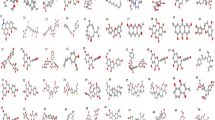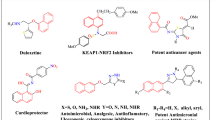Abstract
The present article is an attempt to formulate the three-dimensional quantitative structure–activity relationship (3D-QSAR) modeling of 4-anilinoquinazoline derivatives having promising anticancer activities inhibiting epidermal growth factor (EGFR) kinase. Molecular field analysis was applied for the generation of steric and electrostatic descriptors based on aligned structures. Partial least-squares (PLS) method was applied for QSAR model development considering training and test set approaches. The PLS models showed some interesting results in terms of internal and external predictability against EGFR kinase inhibition for such type of anilinoquinazoline derivatives. Steric and electrostatic field effects are discussed in the light of contribution plot generated. Finally, molecular docking analysis was carried out to better understand of the interactions between EGFR target and inhibitors in this series. Hydrophobic and hydrogen-bond interactions lead to identification of active binding sites of EGFR protein in the docked complex.
Similar content being viewed by others
References
Herbst RS, Fukuoka M, Baselga J (2004) Gefitinib-a novel targeted approach to treating cancer. Nat Rev Cancer 4: 956–965. doi:10.1038/nrc1506
Ballard P, Bradbury RH, Hennequin LFA, Hickinson DM, Johnson PD, Kettle JG, Klinowska T, Morgentin R, Ogilvie DJ, Olivier A (2005) 5-Substituted 4-anilinoquinazolines as potent, selective and orally active inhibitors of erbB2 receptor tyrosine kinase. Bioorg Med Chem Lett 15: 4226–4229. doi:10.1016/j.bmcl.2005.06.068
Rewcastle GW, Denny WA, Bridges AJ, Zhou H, Cody DR, McMichael A, Fry DW (1995) Tyrosine kinase inhibitors. 5. Synthesis and structure–activity relationships for 4-[(phenylmethyl) amino]- and 4-(phenylamino)quinazolines as potent adeonosine-5^ʹ-triphosphate binding site inhibitors of the tyrosine kinase domain of the epidermal growth factor receptor. J Med Chem 38: 3482–3487. doi:10.1021/jm00018a008
Gibson KH, Grundy W, Godfrey AA, Woodburn JR, Ashton SE, Curry BJ, Scarlett L, Barker AJ, Brown DS (1997) Epidermal growth factor receptor tyrosine kinase: structure–activity relationships and antitumour activity of novel quinazolines. Bioorg Med Chem Lett 7: 2723–2728. doi:10.1016/S0960-894X(97)10059-2
Hennequin LFA, Ballard P, Boyle FT, Delouvrie B, Ellston RPA, Halsall CT, Harris CS, Hudson K, Kendrew J, Pease JE, Ross HS, Smith P, Vincent JL (2006) Novel 4-anilinoquinazolines with C-6 carbon-linked side chains: synthesis and structure–activity relationship of a series of potent, orally active, EGF receptor tyrosine kinase inhibitors. Bioorg Med Chem Lett 16: 2672–2676. doi:10.1016/j.bmcl.2006.02.025
Denny WA (2001) The 4-anilinoquinazoline class of inhibitors of the erbB family of receptor tyrosine kinases. Il Farmaco 56: 51–56. doi:10.1016/S0014-827X(01)01026-6
Bridges AJ, Zhou H, Cody DR, Rewcastle GW, McMichael A, Showalter HDH, Fry DW, Kraker AJ, Denny WA (1996) Tyrosine kinase inhibitors. 8. An unusually steep structure–activity relationship for analogues of 4-(3-Bromoanilino)-6,7-dimethoxyquinazoline (PD 153035), a potent inhibitor of the epidermal growth factor receptor. J Med Chem 39: 267–276. doi:10.1021/jm9503613
Ajmani S, Jadhav K, Kulkarni SA (2006) Three-dimensional QSAR using the k-nearest neighbor method and its interpretation. J Chem Inf Model 46: 24–31. doi:10.1021/ci0501286
Wold H (1975) Soft modelling by latent variables: the non-linear iterative partial least squares approach. In: Gani J (eds) Perspectives in probability and statistics, papers in honor of Bartlett MS. Academic, London
Hoskuldsson A (1995) A combined theory for PCA and PLS. J Chemometr 9: 91–123. doi:10.1002/cem.1180090203
Bagchi MC, Maiti BC, Mills D, Basak SC (2004) Usefulness of graphical invariants in quantitative structure–activity correlations of tuberculostatic drugs of the isonicotinic acid hydrazide type. J Mol Model 10: 102–111. doi:10.1007/s00894-003-0173-6
Bagchi MC, Maiti BC (2003) On application of atom pairs on drug design. J Mol Struct THEOCHEM 623: 31–37. doi:10.1016/S0166-1280(02)00659-0
Bagchi MC, Maiti BC, Bose S (2004) QSAR of antituberculosis drugs of INH type using graphical invariants. J Mol Struct THEOCHEM 679: 179–186. doi:10.1016/j.theochem.2004.04.013
Nandi S, Bagchi MC (2007) QSAR analysis of BABQ compounds via calculated molecular descriptors. Med Chem Res 15: 393–406. doi:10.1007/s00044-006-0010-4
Nandi S, Vracko M, Bagchi MC (2007) Anticancer activity of selective phenolic compounds: QSAR studies using ridge regression and neural networks. Chem Biol Drug Des 70: 424–436. doi:10.1111/j.1747-0285.2007.00575.x
Bagchi MC, Mills D, Basak SC (2007) Quantitative structure–activity relationship (QSAR) studies of quinolone antibacterials against M.fortuitum and M.smegmatis using theoretical molecular descriptors. J Mol Model 13: 111–120. doi:10.1007/s00894-006-0133-z
Molecular Design Suite 3.5, VLife Technologies, Pune, India. www.vlifesciences.com
Halgren TA (1996) Merck molecular force field. III. Molecular geometries and vibrational frequencies. J Comput Chem 17: 553–586. doi:10.1002/(SICI)1096-987X(199604)17:5/6<553::AID-JCC3>3.0.CO;2-T
Cramer RD, Patterson DE, Bunce JD (1988) Comparative molecular field analysis (CoMFA) 1.Effect of shape on binding of steroids to carrier proteins. J Am Chem Soc 110: 5959–5967. doi:10.1021/ja00226a005
Stamos J, Sliwkowski MX, Eigenbrot C (2002) Structure of the epidermal growth factor receptor kinase domain alone and in complex with a 4-anilinoquinazoline inhibitor. J Biol Chem 277: 46265–46272. doi:10.1074/jbc.M207135200
Gehlhaar DK, Verkhivker GM, Rejto PA, Sherman CJ, Fogel DB, Fogel LJ, Freer ST (1995) Molecular recognition of the inhibitor AC-1343 by HIV-l protease: conformationally flexible docking by evolutionary programming. Chem Biol 2: 317–324. doi:10.1016/1074-5521(95)90050-0
Verkhivker GM, Bouzida D, ehlhaar DK, Rejto PA, Arthurs S, Colson AB, Freer ST, Larson V, Luty BA, Marrone T, Rose PW (2000) Deciphering common failures in molecular docking of ligand–protein complexes. J Comput Aided Mol Des 14: 731–751. doi:10.1023/A:1008158231558
Hudson BD, Hyde RM, Rahr E, Wood J (1996) Parameter based methods for compound selection from chemical databases. Quant Struct–Act Rel 15: 285–289. doi:10.1002/qsar.19960150402
Kubinyi H (eds) (1993) 3D QSAR in drug design. Theory, methods and applications, ESCOM. Science, Leiden, pp, pp 486–502
Nandi S, Bagchi MC (2009) QSAR of aminopyrido[2,3-d]pyrimidin-7-yl derivatives: anticancer drug design by computed descriptors. J Enzyme Inhib Med Chem. doi:10.1080/14756360802519327
Palmer BD, Trumpp-Kallmeyer S, Fry DW, Nelson JM, Showalter HDH, Denny WA (1997) Tyrosine kinase inhibitors. 11. Soluble analogues of pyrrolo- and pyrazoloquinazolines as epidermal growth factor receptor inhibitors: synthesis, biological evaluation, and modeling of the mode of binding. J Med Chem 40: 1519–1529. doi:10.1021/jm960789h
Kyte J, Doolittle RF (1982) A simple method for displaying the hydropathic character of a protein. J Mol Biol 157: 105–132. doi:10.1016/0022-2836(82)90515-0
Author information
Authors and Affiliations
Corresponding author
Rights and permissions
About this article
Cite this article
Nandi, S., Bagchi, M.C. 3D-QSAR and molecular docking studies of 4-anilinoquinazoline derivatives: a rational approach to anticancer drug design. Mol Divers 14, 27–38 (2010). https://doi.org/10.1007/s11030-009-9137-9
Received:
Accepted:
Published:
Issue Date:
DOI: https://doi.org/10.1007/s11030-009-9137-9




